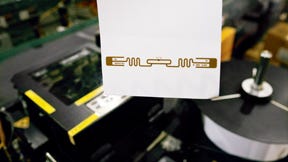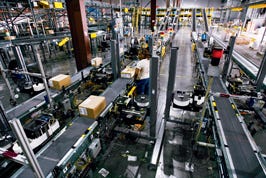RFID labels let Cingular Wireless send the right signals
January 29, 2014

The multiprotocol RFID print engines can be configured for Gen 2 through a firmware download. The cases receive RFID labels as they pass.
Cingular Wireless carries voice and data communications for more than 54 million customers around the world each day. But the Atlanta-based wireless carrier found itself facing a challenge in getting radio-frequency identification (RFID) smart labels to encode correctly for cellphones and subscriber identity modules (SIM, or a smart card, sized similarly to a postage stamp, that securely stores the key identifying a mobile- phone service subscriber, as well as subscription information, saved telephone numbers, preferences, text messages and other information) that it ships to Best Buy and Wal-Mart from its distribution center facility in Memphis.
Considered one of the largest wireless companies in the U.S., with more than 58 million subscribers who use the nation's largest digital voice and data network, Cingular says it's dedicated to providing wireless technology designed to enrich its customers' lives. The company wanted to begin automatically tagging its shipping cases with RFID labels and replace its manual label-application operation in order to expedite and facilitate its picking, printing and shipping processes.
Read how Magnet, a healthcare group purchaser, chose Zebra's BAR-CODE and RFID PRINTERS AND LABELS to reduce medication dispensing errors in hospitals at www.packagingdigest.com/ info/magnet
"We had to operate at a speed of fifteen cases per minute without errors, and had to be able to fix errors quickly, without impacting our production," explains Tracy Yee, IT systems analyst at Cingular, who is heavily involved with the smart-labeling system. "The printer/applicator needed to be RFID-compatible, offer label verification and apply a shipping label, a packing list label, and a UCC-128 label. The entire PNA [print-and-apply] area needed to be able to process forty-five cases per minute."
Cingular worked with Zebra Technologies (www.rfid.zebra.com), single-source software/conveyor provider Fortna (www.fortna.com) and ID Technology (www.idtechnology.com) to design and implement an automatic smart-label print-and-apply system that could be tightly integrated with its warehouse and material-handling operations. With the RFID equipment, networks and warehouse-management system (WMS) interface in place, finding the right smart label was the final detail that made the whole system run reliably and efficiently. Cingular installed an R110PAX4 printer/encoder engine and an ID Technology Model 250 printer/applicator on three conveyor lines set up for in-line print-and-apply label application on packed cases. The R110PAX4 validates that the inlay was encoded prior to being applied. Each line produces 15 cases/min and all three produce 45 cases/min total. Says Yee, "This [equipment] was the best fit for our existing software applications, and we get the best service from our vendors."
The company then turned to Mid-South Marking Systems (www.midsouthmarking.com), another Zebra partner, to find suitable smart-label media that would work well with its packaging, products and processes. Mid-South provided custom RFID roll labels outfitted with inlays and also synchronized the plant's conveying arrangement with the new labeling equipment, and Zebra provided a smart-label material that best suit Cingular's needs.
"Matching smart labels to the printer/encoder is very important," adds Yee. "We tried to do it ourselves, but were going through labels left and right. It got really challenging."

One element for a successful RFID implementation is finding the right media to ensure that the chip and antenna inlay within the label are positioned correctly to work with the printer/encoder. After testing various label media, Cingular chose this smart-label version.
As Cingular discovered, though smart-label printer/encoders and media may support the same standards and RFID protocols, they aren't necessarily compatible. The position of the RFID chip and antenna inlay within the label stock isn't the same in all media. So, if the position of the inlay isn't carefully matched to the specific make and model of a printer/encoder the inlays are being used with, the smart labels may fail to encode properly. Cingular learned this after trialling 30 to 50 unencoded inlays per roll of 800 labels.
Yee points out, "If we hadn't called Mid-South, we might still be working on this. Mid-South and Zebra got us Mid South were the only ones that we tried that had the knowledge and level of expertise that we required."
Currently, Cingular receives orders from Best Buy, Wal-Mart and other national retailers through an electronic data interface (EDI) that links directly into its WMS from Red Prairie (www.redprairie.com). Workers pick cases of cellphones using a pick-to-light system and place them on automated conveyors (from Hytrol [www.hytrol.com) that route them to a sorting area. At this stage, Cingular's WMS creates shipping label information and generates a Serial Shipping Container Code (SSCC) shipping label for each order, assigning a unique electronic product code (EPC) serial number to each case of cellphones and SIMs.

An overview shot of the RFID conveyor lines at Cingular Wireless in Memphis shows three RFID print-and-apply case-conveying lines that together run 45 cpm.
From there, the WMS transmits the pick-file details and label information over Ethernet to the FortnaPlus(TM) real-time warehouse-control software. Fortna led the system design and integration and engaged ID Technology to provide label printing/applicating equipment and related expertise for the project. The warehouse-control software then sends a pick-light signal/message to a particular picking zone to alert the picking operator of a specific number of cases to pick for a stockkeeping unit (SKU). Once the SKU has been picked and scanned, the case is routed down one lane of a set of print-and-apply label lines equipped with the R110PAX4 RFID print engines and the Model 250 label printer/applicators. The data goes into the FortnaPlus software, which inserts the data into the order line and sends another message out to search for the case.
"Smart labels take about 150 milliseconds longer to produce than conventional bar-code labels because of the time required to encode the RFID tag," explains Mark Bowden of ID Technology. "We needed to account for that when we designed a print-and-apply system to work with automated conveyors. Having reliable equipment and supplies are key. If you have a reliable printer/encoder and good tags, you can meet the challenge."
The messages from the WMS to the conveyor system also direct the automated print-and-apply system to detect the cases traveling down the line and to print and encode the RFID smart labels for the particular case SKU and affix it to the case as the case travels by. The Zebra R110PAX4 print engine validates that the RFID tag inlay is properly encoded before the label is applied to the case. After the case is labeled, it moves downline and passes through a set of RFID readers that track and check the smart labels, read them and report the information back to the WMS for a second check. Cingular also uses several Zebra R110Xi tabletop printer/encoders as backups for the higher-speed printer/applicator system, but the R110Xi units have rarely been used, since the company has the "right media selection, which prevents 'bad' tags from being applied to the cases," according to Yee.
With tags in place on the cases, the FortnaPlus control then sends the WMS a "print and apply (PNA) complete" message, which initiates further processing by the WMS as the cases make their way to the end of the line en route to the shipping area where they are loaded onto trucks for shipment.
All of the printer/encoders were upgraded after their original installation in October 2005 to support Cingular's planned transition to the EPC Gen 2 RFID protocol in May 2006. "The transition to Gen Two was completely seamless," notes Yee. "We can't afford disruptions in the warehouse, and didn't have any. We have used Zebra bar-code printers for a while with great results, so expected that their RFID printer/encoders to work as well."
The R110Xi and R110PAX4 have software-defined radios that can be upgraded to support new protocols with a firmware download and can be configured remotely. No replacement parts or hardware changeovers were needed for Cingular to upgrade the printer/encoders to support Gen 2, and the printer/encoders can also still encode other protocols. Cingular also takes advantage of the network connectivity built into its smart-label printer/encoders to view configurations and conduct other management activity.
"Cingular is generating more volume than many other smart-label applications, but this still isn't considered high-volume for automatic print-and-apply systems," notes Bowden. "Print-and-apply systems are capable of much higher speeds. With RFID smart labeling, the key is to prevent a bad tag from being applied to the container. The Zebra print engine has an automatic safeguard for this, so it's a very good fit for an automated system."

Once the cellphones are picked and packed, the case-label data is transmitted to one of the RFID print engines integrated with an automatic label printer/applicator.
Zebra and Red Prairie say they have also collaborated for some time to ensure that the printing/encoding systems Zebra brings to the table can tightly integrate with the WMS software environment. "We weren't going to bring in a printer that hadn't been thoroughly tested and proven with the Red Prairie WMS," Yee says. "We were looking for a way to speed up and automate our shipping/labeling process so that we could more effectively ship to customers. The system we found helps increase our accuracy and productivity. Our operations have been helped tremendously by the PNA area. We are able to pick orders faster and route them down the three lanes that print shipping and packing lists." The results of the RFID equipment and system upgrades have been dramatic, affirms Yee. "Now, we're pretty much running trouble-free. Read rates on the conveyors are close to 100 percent, and the number of inlays that fail to encode is minimal."
Yee says a good way to prevent problems on the packaging lines is to work with printing and media specialists up front. "If we had to do this again, we would have involved Mid-South and Zebra a lot sooner," she says. "We'd rather pay three or four cents more for [an RFID] label and know that it's right for our printer/encoders, than try something less expensive that doesn't work as well and takes a lot of time to correct."
More information is available:
Zebra Technologies, 847/634-6700. www.rfid.zebra.com.
Fortna, 615/376-1919. www.fortna.com.
ID Technology, 888/438-3242. www.idtechnology.com.
Mid-South Marking Systems, 901/360-8207. www.midsouthmarking.com.
Red Prairie, 262/317-2000. www.redprairie.com.
Hytrol Conveyor Co., Inc., 870/935-3700. www.hytrol.com.
About the Author(s)
You May Also Like


